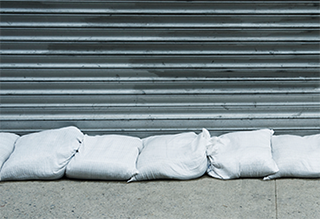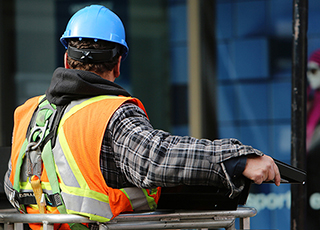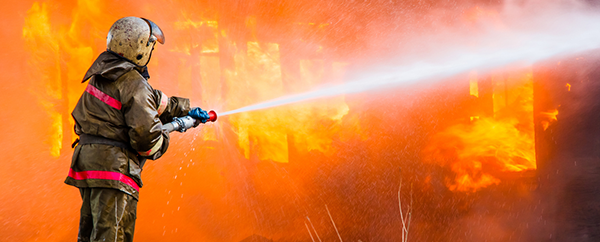How to protect your construction site against damage
- Leading causes of property loss on a construction site are fire, water intrusion and theft.
- Learn the main causes of fire damage and when it’s most likely to occur.
- What causes water damage? Flooding, rain, melting snow, plumbing errors or other deficiencies.
- How can theft be mitigated? Explore these security measures for your jobsite.
What are the leading causes of damage and injury on a construction site? Construction managers and general contractors know – there are myriad exposures to risk on a construction site, from property damage to injuries. Today we’re focusing on property loss – and the major risks that can cause construction site property damage: fire, water and theft.
Construction site damage caused by fire
Local fire departments responded to an estimated average of 3,840 fires in structures under construction and 2,580 fires in structures under major renovation per year in a recent four-year period. The fires in structures under construction caused an average of four deaths, 49 injuries, and $304 million in direct property damage annually, while those in structures under major renovation caused averages of eight deaths, 52 injuries, and $104 million in direct property damage annually.
Interestingly, cooking equipment is the leading cause of fires onsite – 27 percent – but these fires tend to be minor. Here are a few more fire statistics from the National Fire Prevention Association (NFPA):
- 75 percent of construction fires occur in residential properties.
- Fires are highest in cold weather months: Nov. – March.
- Construction fires are most common in the afternoon and early evening.
- Fires that occur between midnight and 4 a.m. accounted for 32 percent of property damage.
What are the leading factors contributing to fires?
Exposed wood either piled up or framed is kindling just waiting to go up in flames. And on commercial construction sites, fire suppression systems are among the last to be installed. That means it’s difficult to fight fires on the site, regardless of how many fire extinguishers are on hand. Add to the mix the wealth of flammable materials – and the result is a significant fire risk. Causes of fires causing construction site damage include
- Electrical failures or malfunctions due to temporary wiring
- Abandoned or discarded materials or products, i.e. fuel
- Hot work (welding, grinding, cutting) too close to flammable materials
- Heating equipment malfunctions
- Smoking
How you can reduce fire risk
- Prohibit smoking within the structure or near flammables. Designate a smoking area far away from anything that might catch fire. Post signs and enforce the rules vigilantly.
- Any temporary lighting or heating should be approved by a pre-designated person.
- Heaters should be on non-combustible floor or platforms, and the area round them should be clear of any materials.
- Have plenty of fire extinguishers on hand, and ensure everyone knows how to work them.
- Keep the worksite free of discarded materials that could go up in flames.
Related: Help clients stamp out construction fire hazards
Construction site damage caused by water or flooding
Water damage can bring an entire construction project to a halt. From  rain entering a structure through openings in the roof and unfinished windows, to flood waters that appear when snow melts, to plumbing systems that leak when tested, water damage is the second most frequent cause of loss to buildings under construction.
rain entering a structure through openings in the roof and unfinished windows, to flood waters that appear when snow melts, to plumbing systems that leak when tested, water damage is the second most frequent cause of loss to buildings under construction.
It can ruin interiors and damage electrical equipment, says MunichRe. Water can rot wood or cause it to swell and shift. Too much moisture can lead to mold growth, which is expensive to remediate. It can cause construction delays, waiting for affected areas to dry out and damaged materials to be discarded and replaced. It can reduce profit and add significant delays to completion schedules through clean up and replacement times. The contractor will pay at least some of the costs out of their own pocket in the form of deductibles, debris removal costs that exceed the insurance coverage, and income lost due to delays even when insurance applies to the loss.
What are the leading causes of water damage?
- Rain entering through roof openings, roof drains, door and window openings
- Cracks and separations in waterproofing structures
- Deficiencies in doors, windows, walls, roofs or gutters
- Flooding
- Deficient drainage system, plumbing or mechanical systems or fire protection system
Related: How to create a construction site-specific safety plan [Infographic]
How you can reduce the risk of water damage
First, only allow licensed and experienced plumbers on the job. Everyone working onsite should know where pipes are located to avoid digging too deep. Keep up with regular quality control testing and conduct periodic inspections throughout the construction process.
Water detection systems should be in place, allowing workers to act fast if something goes wrong. Early detection can lessen the amount of damage, so ensure all workers know how to respond to and report any potential leaks. An electronic leak detection system can alert you to potential uncontrolled water as well, says Big Rentz, particularly if the damage happens when no one’s onsite.
Have equipment available to remove water such as industrial fans and dehumidifiers, so that water can be expunged promptly, lessening the water damage.
Related: Tools & tips to prevent construction fall hazards
Construction site theft
The third major cause of construction site damage is theft. With the recent  surge in construction materials and tools since the pandemic set in, thefts have skyrocketed.
surge in construction materials and tools since the pandemic set in, thefts have skyrocketed.
“Thieves target construction sites like wolves hunt sheep,” says Amarok. “They’re easy targets. Most sites are poorly lit. They’re unmanned during the night. And they’re littered with high-value items to steal.”
How you can reduce theft and vandalism on a construction site
Before a building is complete, fewer physical barriers keep people from entering without proper authorization. Temporary fencing is often used to set a perimeter, but that fencing is fairly easy to scale or break through. Windows and doors serve as barriers, but these are often some of the last things to be put up on a building.
Start with a site security plan and prevention policy. Amarok suggests your policy include such statements as “Borrowing tools or removing scrap for personal use is prohibited.”
Next, install and maintain a strong physical barrier along with warning signs and lighting. Consider a single locked access gate that is only accessible to subcontractors and members of your team, says Big Rentz.
Ensure equipment left at night is specifically marked, including the company’s logo or owner’s name. Beginning in 2000, equipment manufacturers created a standard 17-digit product identification number (PIN) system. Engrave every piece of your equipment with its respective number, then write it all down in a ledger. Make it harder to steal equipment by removing keys, batteries or wheels, says Amarok. Otherwise, it’s easy for the thief to pawn it for easy cash.
Consider adding security systems and surveillance, including cameras placed around the site, along with sensors and alarms. Some advanced sensors can detect water exposure, temperature changes or breaking glass, providing a better idea of exactly what is happening onsite. If the job site is in a high crime area or has been broken into before, consider hiring a security guard during non-working hours.
Big Rentz also suggests keeping tools and equipment locked up and materials out of sight when not in use. Keep inventory tracking up-to-date so things can’t easily go missing. Consider ordering materials as they’re needed rather than stockpiling items onsite.
By taking these extra precaution and security steps, you’re less likely to incur construction site damage from fire, water intrusion or theft.

